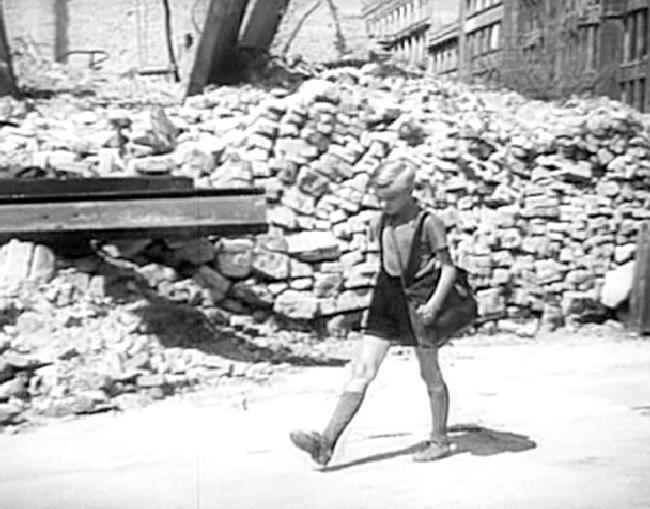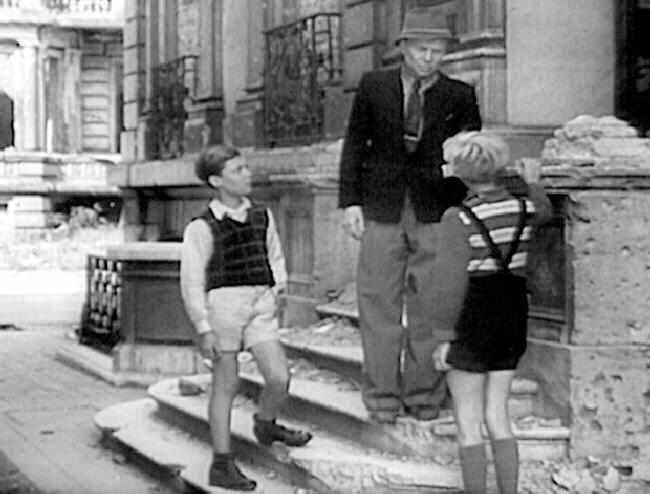
Germany Year Zero (Germany, 1947)

Figure 1.-- The entire film is set against the background of
Berlin after it had been bombed almost out of recognition. The ruined city
mirrors the ruined lives of the Koeler family and especially of Edmund, its
youngest member. The acting of Edmund's role is beautifully and sensitively
done.
|
Germany Year Zero is a dark and disturbing film, directed with detachment by Rosselini. It is really year zero for the German people, trying to rebuild lives that can never be fully restored. As in The Search (1948), war's devastation, physical and spiritual, becomes an omnipresent and silent character in this film, as well. These films would interest any viewer curious about this time and place. The films couldn't be more different, however. "The Search" ends (the very last scene, indeed) with mother and son reunited; music and a choir that sound nothing short of angelic are added to enhance our great sense of happiness for them. Year Zero ends in a tragedy which only heightens the grimness of this film.
Filmology
Germany Year Zero was directed by Roberto Rosselini, the Italian Neo-Realist. This gritty film was shot in Berlin in the summer of 1947. Rosselini used non-professional actors, and it depicts graphically the devastation of post World War II Germany. The central character is 12-year old, Edmund, who struggles to survive in war's aftermath.
Neo-Realism
These neo-realist films are especially interesting for HBC because they so accurately depict conditions and clothing. The economic conditions meant that very little money was available to finance these films. Film makers could not afford established actors. Rather than elaborate sets, a lot of filming was done on the streets. Shots in the film here so the devestated landscape of German cities after the War. Little money was available for costuming. Often the actors wore their own clothes. Thus the depictions are a veey accurate look at contemprary conditions and clothing.
Setting
The film is set in the almost totally destroyed city of Berlin in 1947. The background seen here (figure 1) was not a movie set. This was how Berlin and many other German cities looked after World War II as a result of the Allied strategic bombing campaign. Germans confronted a bleak landscape as they tried to pick up their lives.
Cast
The star of the movie is the child actor Edmund Meschke who plays Edmund Koeler. The acting of Edmund's role is beautifully and sensitively done. Partly because of his acting, the film at times is painful to watch. I do not know if he was in any other films.
Edmund
Edmund is a 12-year-old boy who tries desperately to help his starving family by any means to hand. Edmund lives with in a Berlin flat with his father, older sister, and older brother. His father is dying of a weak heart and malnutrition and his older brother Karl Heinz can't get work and is in partial hiding. The police are looking for him because of his previous service to the NAZI regime. He was in army and fought the advancing Soviets in street combat. Now, he fears he will be interned and separated from his family. [HBC note: I don't fully understand the premise of the film. The Western Allies didn't prosecute soldiers unless they were invoilved in war crimes. Perhaps he was coincdrned about the Soviets. Here I am less sure about their practices.] A former teacher exploits Edmund by getting him to sell NAZI propaganda on the black market and teaching him that the weak only burden the strong. Misguidedly, Edmund poisons his own father in an attempt to put him out of his misery and then feels guilt and confusion. In despair Edmund finally leaps to his death from the top floor of an abandoned building. The entire film is set against the background of Berlin after it had been bombed almost out of recognition. The ruined city mirrors the ruined lives of the Koeler family and especially of Edmund, its youngest member. Their sister, Eva, cooks and cleans for the family, and contributes what she can to support them. The family lives in the kitchen of the flat, which they appear to be sharing with at least two other families. So many people crowded together easily exceed their ration of electricity and are punished by tte authorities with fines and temporary loss of power.

Figure 2.-- A former teacher exploits Edmund by getting him to sell Nazi propaganda on the black market and teaching him that the weak only burden the strong. Misguidedly, Edmund poisons his own father in an attempt to put him out of his misery and then feels guilt and confusion. .
|
Plot
As the film begins, Edmund is discharged from a work group because he's too young. As he walks home, he sees a crowd of people slicing up a dead horse for food. A policeman chases him away from a little coal that's fallen out of a passing truck. Everywhere is the hulk of what used to be a vibrant city. Everyone in the flat is desperate. The flat owner sends Edmund to pawn a scale, but a dishonest buyer cheats him in the deal. Edmund encountered his old school teacher, Mr. Enning, who listens to his plight, then gives him, Jo and Kristel, to see that he's not cheated this time. Eddmund got a price for the record and received a nice share of the proceeds from Enning. Edmund falls in with the older boy and girl, who are making their way by stealing. He returned home after being out all night. His sister and father scold him. Soon, the father's condition worsens due to the poor diet they all share. He goes into hospital and improves with rest and care. By now Jo and Kristel have tired of the younger Edmund, and the boy returns to Mr. Enning to see if there is anything more to hock. Edmund tells his old teacher about his family's living conditions. Enning offers Edmund the opinion that his father has become a burden on the family; everyone would be better off if he were to die. The strong must be willing to sacrifice the weak. he said. Unfortunately, Edmund turned out to be quite impressionable. While visiting his father in hospital, Edmund stole a bottle of medicine; its label indicated an overdose could be fatal. Edmund served his father an overdose of the drug by disguising it as a cup of tea which his father had wished for. Almost at once things went downhill rapidly for Edmund. Just before dying, his father says that though he's lost all else, he still has his children, whom he loves. Karl-Heinz turns himself in to the police, but he's soon released. He and Eva are distraught by their father's death, and they make plans to move. Edmund refused to go with them, preferring to make his own way. First, he went to Jo and Kristel, but they want nothing to do with one so young. He went to Mr. Enning and told him what he had done, but Enning denied telling the boy to kill his father. Edmund, as shattered now as the ruined cityscape he walks along,
is even rejected by a group of younger boys when he tried to join their soccer game. Edmund climbed around the ruins of a building across from where he and his
family had been living. He saw them and heard their calling for him. Instead of answering, Edmund jumped to his death.
Costuming
In the film Edmund wore a light grey pull over short-sleeved pullover shirt with a pointed collar, rather short black shorts, grey knee socks, and
scuffed shoes. Throughout the film Edmund wears black suspender shorts and a knit sport shirt, sometimes with a sweater. He wears both grey and dark knee socks. At one point we
see him with another boy of about the same age who dresses similarly but with
ankle socks instead of knee socks. Early in the film he put on the light shirt over a T shirt with bands of dark stripes, alternating wide and narrow. Edmund wore dark suspenders with his shorts. Later in the film, Edmund is seen in a grey dress coat with a belt in back and white dress shirt, but with the same shorts, socks, and shoes. Most of the boys, even the older teens wear short sleeved, collared pull over shirts and shorts, though some of the older boys wear dark short socks with light colored shoes. A few of the older boys wear long trousers. The younger boys all wore shorts, some with, some without suspenders. Edmund's suspender shorts barely cross at the back, but quite near the waistband.
Assessment
Germany Year Zero is a dark and disturbing film, directed with detachment by Rosselini. It is really year zero for the German people, trying to rebuild lives that can never be fully restored. As in The Search (1948), war's devastation, physical and spiritual, becomes an omnipresent and silent character in this film, as well. These films would interest any viewer curious about this time and place. The films couldn't be more different, however. "The Search" ends (the very last scene, indeed) with mother and son reunited; music and a choir that sound nothing short of angelic are added to enhance our great sense of happiness for them. Year Zero ends in a tragedy which only heightens the grimness of this film.
HBC

Navigate the Boys' Historical Clothing Web Site:
[Return to the Main "Ga-Gl" movie page]
[Return to the Main alphabetical movie page]
[Introduction]
[Activities]
[Biographies]
[Chronology]
[Clothing styles]
[Countries]
[Theatricals]
[Bibliographies]
[Contributions]
[FAQs]
[Glossaries]
[Satellites]
[Tools]
[Boys' Clothing Home]
Created: June 15, 2002
Last updated: 2:52 AM 9/11/2004




